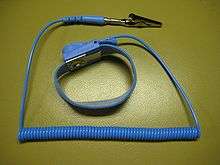Antistatic wrist strap
An antistatic wrist strap, ESD wrist strap, or ground bracelet is an antistatic device used to safely ground a person working on very sensitive electronic equipment, to prevent the buildup of static electricity on their body, which can result in electrostatic discharge (ESD). It is used in the electronics industry by workers working on electronic devices which can be damaged by ESD, and also sometimes by people working around explosives, to prevent electric sparks which could set off an explosion. It consists of an elastic band of fabric with fine conductive fibers woven into it, attached to a wire with a clip on the end to connect it to a ground conductor. The fibers are usually made of carbon or carbon-filled rubber, and the strap is bound with a stainless steel clasp or plate. They are usually used in conjunction with an antistatic mat on the workbench, or a special static-dissipating plastic laminate on the workbench surface.

The wrist strap is usually worn on the nondominant hand (the left wrist for a right-handed person). It is connected to ground through a coiled retractable cable and 1 megohm resistor, which allows high-voltage charges to leak through but prevents a shock hazard when working with low-voltage parts. Where higher voltages are present, extra resistance (0.75 megohm per 250 V) is added in the path to ground to protect the wearer from excessive currents; this typically takes the form of a 4 megohm resistor in the coiled cable (or, more usually, a 2 megohm resistor at each end).
Wrist straps designed for industrial use usually connect to Earth Bonding Points, ground connections built into the workplace, via either a standard 4 mm plug or 10 mm press stud, whereas straps designed for consumer use often have a crocodile clip for the ground connection.
In addition to wrist straps, ankle and heel straps are used in industry to bleed away accumulated charge from a body. These devices are usually not tethered to earth ground, but instead incorporate high resistance in their construction, and work by dissipating electrical charge to special floor tiles. Such straps are used when workers need to be mobile in a work area and a grounding cable would get in the way. They are used particularly in an operating theatre, where oxygen or explosive anesthetic gasses are used.
"Wireless" or "dissipative" wrist straps are available, which claim to protect against ESD without needing a ground wire, typically by air ionization or corona discharge. These are widely regarded as ineffective,[1][2][3] if not fraudulent, and examples have been tested and shown not to work.[4][5] Professional ESD standards all require wired wrist straps.[1]
-

Disposable ground straps used during installation of computer equipment
-

See also
References
- 1 2 Namaguchi, Toshikazu; Hideka Uchida (1998). "Wrist strap designs and comparison of test results for MIL-PRF-87893 and ANSI EOS/ESD Association S1.1". Electrical Overstress/Electrostatic Discharge Symposium Proceedings, October 6–8, 1998, Reno, Nevada. USA: ESD Association, Institute of Electrical and Electronics Engineers (IEEE). pp. 3B.4.3. 1878303910.
- ↑ mctsolchris (June 10, 2011). "Antistatic Wrist Straps". BYOPC Blog. Micro Center Tech Support Online. Retrieved January 21, 2013.
- ↑ Laumeister, Bill (March 2, 2011). "Tutorial 4991: Oops...Practical ESD Protection vs. Foolhardy Placebos". Application Notes. Maxim Integrated. Retrieved January 21, 2013.
- ↑ "Evaluation of Wireless Wrist Straps". ESD Journal. Fowler Associates, Inc. October 27, 2005. Retrieved January 21, 2013. External link in
|work=(help) - ↑ "Question #17". Questions and Answers. Desco Industries. Retrieved January 21, 2013.